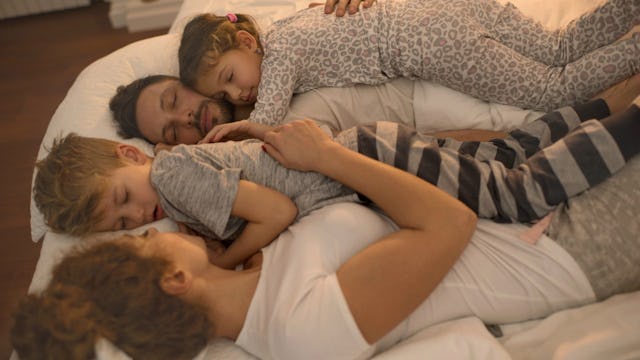Yes, My Family Co-Sleeps, And This Is Why

When our daughter Ever Elizabeth was less than 1 month old, she was hospitalized. Night after night she lay in the hospital bed, a high-rise crib surrounded by snaking tubes, wires, all springing from our tiny baby as if she were an alien pod, providing priceless energy. She lay still. I tested the side rail. I waited for the nurse to leave. My husband watched. I carefully climbed over the crib walls, a dance of careful, miniature movements: Do not clip the wires, do not yank the wires, do not unseal the tubes. My legs bent awkwardly. I curled my body around hers as she lay flat on her back, and breathed into her face.
The moment she first turned her head and rooted to nurse, weakly, I could not stop the tears. The nurses appeared, flushed, surprised, laughed. They allowed me to sleep with Ever every night and during the day, climb up the crib castle and lay pressed into my baby until she was removed from the wires and the tubes and we could take her home.
The act of lying next to her was the most healing and comforting thing that I did the entire hospital stay. Letting me do so was the most human thing the staff did. I believe she healed more deeply because I was next to her. I believe I healed more deeply.
My family does not live in a hut, nor do we milk goats for our sustenance, eat carob, grow corn or shun deodorant. We do, however, sleep in a family bed. For a long, long, long, long time. It’s one of the most culturally rebellious choices I’ve ever made, living here in San Diego suburbia. My husband is one of those people who quietly and easily does what he feels is best for our family, without feeling the need to either discuss or defend our practices.
It’s a little harder for me. I like to be close to people, not just friendly. So when I’m making a new friend, I have always gravitated toward chatting quickly past the surface of things and talking about the stuff of life—how we live, what we feel and think. The raised eyebrows and uncomfortable foot shuffling that occurs when I tell people about our sleeping practices are hard to take.
But not as hard as it would be for me to forgo sleeping with our kids. From the time they were born, they have slept next to us. We practice safe co-sleeping for infants. Co-sleeping is safe, like many things, when done correctly. No big, fluffy blankets. No pillows. No drinking. If my husband or I had a sleep disorder, we might not co-sleep. The baby wakes, nurses, falls back asleep. It’s easy.
As our children grow older, co-sleeping becomes more than a primal, protective closeness. It becomes a sanctuary from the world, a place where, even if the day has been long and hard and there have been tears, rejection at school or self-doubt, the pack of our family comes together, and there is a very powerful sense of connection and rejuvenation of spirit.
When Ever has a nightmare, she sometimes wakes and sits up, breathing heavily. She puts her hand out and rests it on me, and says, “Mommy?” I say, “Yes, sweetie,” and that is all she needs. She lies back down and sleeps.
Instead of creating an inability to independently self-soothe—a concern I’ve heard—what I have seen in all of my children is the exact opposite. The more they are soothed by my husband and me, the more able they eventually are to self-soothe. Their nerves are calm. They feel safe. They trust that someone will always be there. All of my four children were very independent by age 3. They go easily to other friends and family for babysitting, they can play alone and amuse themselves, and they can sleep alone, if it comes up!
As for the other concern I hear, my husband and I, after 13 years of marriage, have a more—ahem—robust sex life than many twenty-somethings I’ve known. Unless you live in a studio apartment, it’s not impossible to find a way to keep the physical intimacy alive with your partner.
As our children get older, the family bed becomes elastic. It comes and goes as needed, and there are nights when we lie in bed with our two youngest, ages 4 and 13, and the teenager and I talk into the night as her sister sleeps. It is those sleepy conversations that often reveal the most vulnerable parts of my children, where they say things that might feel too revealing in the light of day.
Co-sleeping is all things human: the embarrassing, gas and snores; the adorable, giggles and hugs; and the mundane and human open-mouthed sleeps. Although the dark can be all-consuming and our minds and hearts can go dark alongside the night, the body of one who loves us can be a shield against a world in which our children have to find their way. We can find peace, and comfort, and shelter in one another.
This article was originally published on